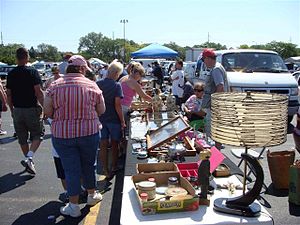| Furniture conservation - applying paint remover (stripper) (Photo credit: Wikipedia) |
(VOCs, or Volatile Organic Compounds, are chemicals released from the paint. They can cause illness and disease for many years to come as they are released into the air for decades.) You can also strip and stain the furniture with natural and VOC-free stains.
#2. Reupholster it. Have a piece of furniture that you like but doesn’t quite match your current décor? Reupholster it with environmentally-friendly fabric like organic cotton or wool. And if upholstering is too big of a do-it-yourself job, take it to an expert. It’ll cost less than buying new and is a more environmentally-friendly choice.
#3. Add bits of finery. Cabinets, drawers, and armoires can be spruced up with a little bit of new hardware. You can often purchase the hardware from a flea market or a salvage store. They’re great places to find hardware with personality.
| A Chicagoland Flea Market. (Photo credit: Wikipedia) |
Finally, you can also use sheets of scrap metal or recycled metal to create flash on tabletops or cupboard fronts. The metal can be used as tiles or as an entire front to add an urban or contemporary touch.
People have used everything from chicken wire to astro turf to add flair and personality to old furniture. There are a million green ways to make old furniture new again - it just takes a bit of creativity. Take a look at what you have around you and how you can make good use of it in an eco-friendly way.
Helpful Resources on Refinishing and Reusing Furniture:



No comments:
Post a Comment